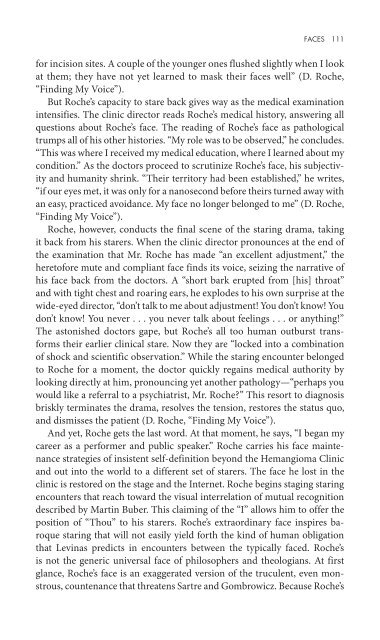Staring how we look sobre la mirada.pdf - artecolonial
Staring how we look sobre la mirada.pdf - artecolonial
Staring how we look sobre la mirada.pdf - artecolonial
You also want an ePaper? Increase the reach of your titles
YUMPU automatically turns print PDFs into web optimized ePapers that Google loves.
KNOWLEDGE GATHERING 51<br />
out as alien, a staree is at once cornered and empo<strong>we</strong>red. After all, the sight<br />
of a staree has brought a starer to his or her cognitive knees. Baroque staring<br />
thus exposes both its participants.<br />
The Enlightenment turn toward the decorous and the staid banished<br />
wonder into the realm of vulgarity. Art, as <strong>we</strong>ll, trivialized the baroque by<br />
transforming it into rococo and eviscerated it with neo-c<strong>la</strong>ssicism. Baroque<br />
staring at wonders became itself an oddity. Wonder evolved into proper<br />
<strong>look</strong>ing. 10 Nonetheless, baroque staring can serve as a useful way to understand<br />
responses to startling sights in any period. Because baroque staring<br />
indicates wonder rather than mastery, it can lead to new insights. Mastery<br />
closes down knowledge; wonder opens up toward new knowledge. Mastery<br />
dominates starees; wonder p<strong>la</strong>ces starer and staree in dynamic re<strong>la</strong>tion. As<br />
both verb and noun, wonder names the object and act of staring. To wonder<br />
means to want to know. A wonder is a source of knowledge. Baroque stares<br />
exceed, then, interested <strong>look</strong>ing. A literally gripping sight provokes baroque<br />
stares even in our contemporary moment. In other words, <strong>we</strong> still wonder<br />
at wonders.<br />
STARING AT OURSELVES<br />
We stare to know, and often <strong>we</strong> stare to know ourselves. Perhaps, as Jacques<br />
Lacan (1977) suggests, our first baroque stares are at ourselves. 11 Being caught<br />
off guard by a surprising version of ourselves in some reflective surface is one<br />
of the primal scenes of staring. Visual self-regard is strange because of the<br />
limits of human perception. Our faces are the seat of the senses, the p<strong>la</strong>ce<br />
from which <strong>we</strong> recognize the world, and also the location of recognition,<br />
differentiation, and affirmation from others. Our own faces are intimately<br />
familiar to us through the senses of smell, touch, hearing, taste, but never directly<br />
through sight. Paradoxically, <strong>we</strong> are denied the sight of our own faces,<br />
that most human, intimate sight of our particu<strong>la</strong>r self. We cannot directly<br />
recognize ourselves in a way that others know us. We experience ourselves as<br />
a body moving through the world that touches and is touched by our environment,<br />
as the philosopher Maurice Merleau-Ponty (1962) points out. But<br />
<strong>we</strong> can only see the very particu<strong>la</strong>r self that <strong>we</strong> are through the mediation of<br />
images or reflections, which reverse our appearance so that what <strong>we</strong> see is a<br />
slightly distorted mirror image of <strong>how</strong> <strong>we</strong> <strong>look</strong> to others. The person in the<br />
mirror or the photograph is not the person <strong>we</strong> experience ourselves to be;<br />
rather, that person is the one others see. This disjuncture bet<strong>we</strong>en seeing and<br />
being ourselves encourages self-scrutiny. We learn to monitor ourselves and<br />
calcu<strong>la</strong>te our appearance through intently <strong>look</strong>ing at these images, through


